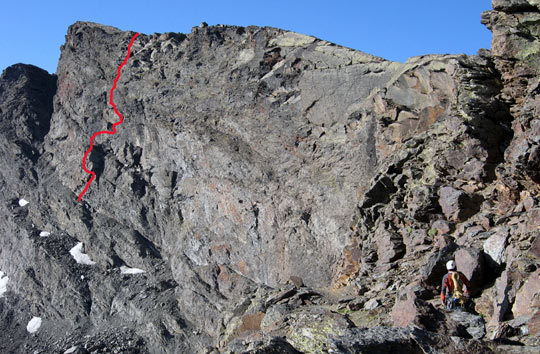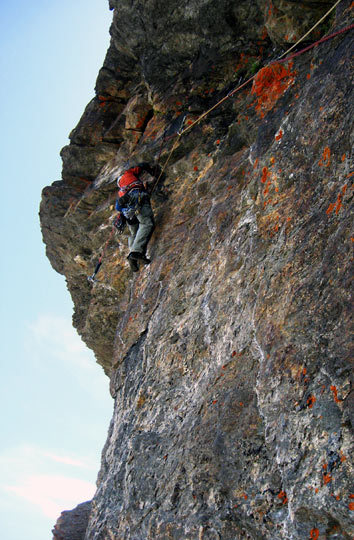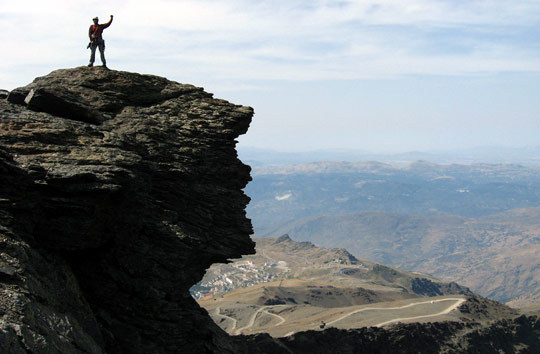
Jonathan Trango approaches his new route, Poema de los Vogones (ED: 7b or 6b obl. A2, 8 pitches, 280m), on the north face of Pico Veleta (3390m), the most technical alpine wall in the south of Spain. He and Manolo Gomez Trujillo climbed the route on August 9. They onsight freed every pitch except Pitch 5, in which one roof move continues to resist Trango’s attempts. [Photo] Manolo Gomez Trujillo
This summer I had the fortune to climb in the north of Spain, where some locals and I opened routes in the best style–climbing from the ground up, as clean and free as possible. The trip inspired me to return south to my home, Malaga, and team up with Manolo Gomez Trujillo for a new route in the Sierra Nevada range of Andalusia, in southern Spain.
On August 9, we established Poema de los Vogones (ED: 7b or 6b obl. A2, 8 pitches, 280m) on the north face of Pico Veleta (3390m). The line follows obvious crack systems but has delicate and exposed climbing on poor rock throughout. Like most walls in the Sierra Nevada, the metamorphic stone lends itself to bad gear protection, slopey holds, rotten rock and loose blocks. In many places you have to be careful, as it’s easy to rip off the only holds available.
The crux, Pitch 5, is an impressive overhang. It’s largely impressive because it requires climbing through the worst rock I have ever seen. It took us three hours beginning to end–cleaning, aiding, fixing gear and freeing what we could (we onsight freed everything except Pitch 5).

Jonathan Trango climbing Pitch 5, the crux of the route. Trango attests that “very loose, rotten and dirty rock was the real crux of the pitch, and the whole route.” [Photo] Manolo Gomez Trujillo
I don’t like fixing gear unless I have to. With no fixed protection, this climb could probably be aided at A3+, but since I intended to climb it free–without dying–I hand drilled three rivets and bashed in three in situ pitons where natural gear could not be used. These pieces are the only gear we fixed on the route. On Pitch 5 the crux move, and a number of others, still require natural pro placements.
The grade reflects our general assessment of the route, which means that it takes into consideration the difficulty as well as the poor rock quality and committing gear placements in the sketchy rock. If the same holds were clean and solid at a sport climbing crag, with bolts every couple meters, the route might go at 7a–but climbing in the Sierra Nevada is a different story altogether.
A few days after opening the route I came back to redpoint the hardest pitch. But going through the roof crux I still took a fall on the cam placement–that surprisingly resisted blowing out of the bad rock–so the redpoint still awaits.
I plan to return and free the crux. But even as it stands, the route likely is the most exposed and difficult climb in the Sierra Nevada, the Iberian Peninsula’s highest mountain range.

Jonathan Trango celebrating atop Poema de los Vogones. [Photo] Manolo Gomez Trujillo